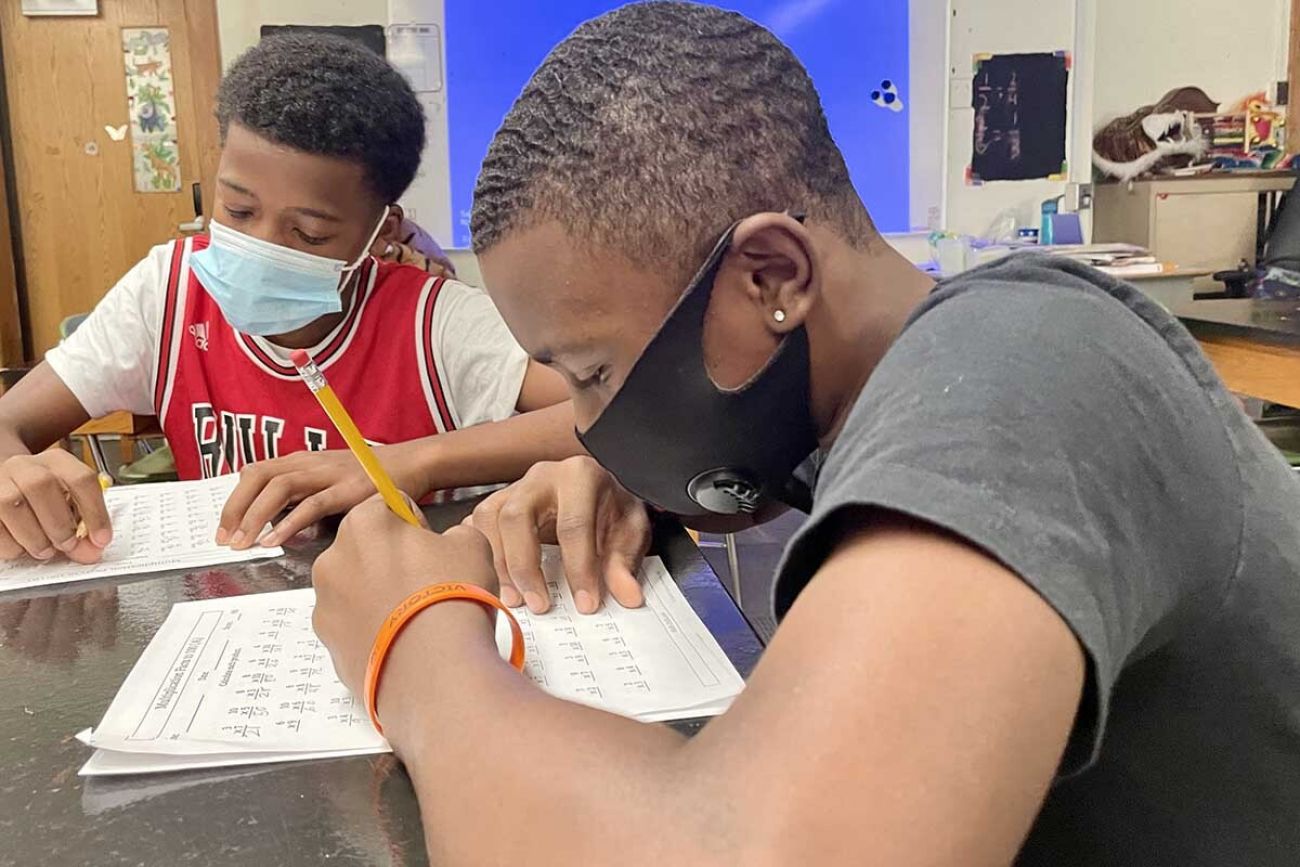How many COVID cases are in Michigan schools? State has no idea anymore

The onslaught of the omicron variant of COVID-19 is crumbling Michigan’s system for reporting outbreaks in schools, making it difficult for parents to know how widespread the virus is in classrooms.
Some districts have told parents to work under the assumption that there could be COVID present in all schools and classrooms.
Earlier this month, the state advised local health departments they no longer had to do broad contact tracing, which many departments had already abandoned anyway.
Related:
- COVID may be here to stay. So much of Michigan is weighing risks, moving on
- Michigan schools running short on COVID tests, imperiling in-class learning
- Mailbox-bound: Free COVID tests now available for Michigan homes
- Omicron requires a better mask. How to choose one that’s best for you.
Without contact tracing to allow districts to identify students and staff to test and quarantine, local health departments are unable to supply data to the state for weekly reports tallying school outbreaks.
Those reports, which health officials say were always an undercount of total COVID cases among students and staff, are now even less accurate.
Elizabeth Hertel, director of the Michigan Department of Health and Human Services, acknowledged the stress on parents.
“With the number of cases and contacts that we have, we just do not have the human resources across the state to do all of that contact tracing,” Hertel told Bridge Michigan on Wednesday.
That worries Nicole Kessler, a parent of a fifth-grader in Birmingham Public Schools in Oakland County. She fears low outbreak numbers will feed “a narrative that there is no spread in the schools,” when, she said she believes, “that’s not the case.”
“As a parent, it (misleadingly low school outbreak data) gives us a false sense of security as to what is actually happening in our schools,” Kessler said. “We don’t know then if the spread is happening in the school environment or from the community.”
This week, COVID cases hit another high, as the state reported an average of 17,589 cases for the past seven days. By comparison, average daily cases had dipped to under 200 last summer.
Local health officials “are doing everything they can” to track COVID, Hertel said.
But nearly two years into the pandemic and as the highly contagious omicron variant races across the state, it’s increasingly up to individuals to help control spread — to self-test, alert close contacts after a positive test and isolate and quarantine when recommended, she and other health officials have said.
Local health departments, too, would like to continue contact tracing, but “what is ideal and what is realistic — that’s where we’re hitting the rub now,” said Norm Hess, director of the Michigan Association of Local Public Health, which represents the state’s 45 local health departments.
“The system is overrun,” agreed Keith Smith, superintendent of Kingsley Area Schools in northwest Michigan.
A parent complained recently that his district’s COVID dashboard has not been updated for a month, he said.
“What can I say? I update it when I get the information, but it’s not unusual for notifications (of a positive case) to come three weeks later or more,” he said.
Hazel Park Schools in Oakland County is among the districts that have stopped contact tracing. “We are saying (to families), use your best judgement” about whether a child should be tested for being possibly exposed to a classmate who has tested positive, said Superintendent Amy Kruppe.
Farther north in Oakland County, Oxford Community Schools’ superintendent sent a letter to parents in early January saying the district was going to stop sending notifications of school or class COVID exposures, because the number of cases was overwhelming the district’s ability to keep up.
“Given the current trend and the prevalence of the new COVID variant, it is fair to assume that COVID could be present in every classroom and building,” wrote Oxford Superintendent Tim Throne.
Complicating contact tracing for schools is a “COVID test supply crisis.” first reported by Bridge Michigan, that may leave even the schools that want to continue contact tracing and test-to-stay policies with no tests as early as next week, according Ingham County Health Officer Linda Vail.
Thursday afternoon, after Bridge reported the issue, Gov. Gretchen Whitmer announced a “surge” of 300,000 test kits to schools and other high-priority locations such as jails and long-term care facilities. Schools are receiving 117,000 of the kits.
“Tests are critical (to) keeping Michiganders safe and controlling the spread of COVID-19,” Whitmer said in a statement.
Hertel told Bridge that shipments are being sent to schools, but there may not be enough to meet demand.
‘You are going to face exposure’
The school outbreak report is separate from the state’s official COVID-19 count.
The outbreak report is based on COVID data first collected from schools, and then analyzed by local health departments to determine if the cases are likely linked to a school or school activity. If there are three or more positive cases linked to the same source, it is considered an outbreak.
That definition of a school outbreak meant the tally was always an undercount of total COVID cases in schools. For example, a second-grader who is believed to have caught COVID from his father wouldn’t be included in the data.
But the scope of the omicron surge, along with changes in contact tracing policies, has made the report even less reliable.
For example, in the most recent report, which includes school outbreak data for the week of Jan. 6 to 13, Oakland County, the state’s second most-populous county, reported just one outbreak involving five students.
Some districts are continuing to report — Howell Public Schools in Livingston County reported 166 COVID cases linked to school outbreaks in the past week — but reporting is inconsistent around the state.
Norway Elementary in the Upper Peninsula, for instance, closed last week when one in six students tested positive in one day. But the outbreak isn’t in the state report.
“School cluster (outbreak) data is not reliable, which is due to the surge in cases,” said Bill Mullan, spokesperson for Oakland County government and Oakland County Health Department. “There are too many cases to accurately identify clusters in schools. This is true in every county.”
About 28,000 Michigan children between the ages of 5 and 18 contracted COVID since Jan. 3, according to state data.
Only 560 cases, though, are tallied in the state’s school outbreak data report for approximately the same time period, and that figure includes students and staff.
“It’s really just a numbers game at this point,” Mullan said. “Just make the assumption, everywhere you go, you are going to face exposure.”
Can’t keep up
Robert McCann, executive director of the K-12 Alliance of Michigan, a school advocacy organization, said without more staff in schools and local health departments, reporting can’t keep up with the case surge.
“Nearly everybody is an exposure risk at this point,” McCann said. “It’s very complicated to expect schools to be able to (contact trace) now.
Hazel Park superintendent Kruppe said she’s not sure children are hurt by the end of contact tracing in schools.
“Most of what we heard (from students who tested positive) was ‘My grandma had it’ or ‘My little brother had it,” she said. “I think it (COVID spread) is mostly in the community.”
Earlier in the pandemic, before omicron, research found that in-person learning didn’t contribute to the spread of the virus. Since omicron, though, research is evolving.
Children are less likely to suffer serious illness from COVID, but there are now 127 children hospitalized statewide with the virus, the most of the pandemic.
Children can be exposed to COVID just about any time and anywhere, acknowledged Erin Stepek, regional group leader of the Michigan Parents Alliance, which has advocated for universal masking in the state’s schools.
Still, she’s “grateful” that her children’s school district, Wayland Union Schools, in Allegan County, continues to contact trace, even if it doesn’t mandate masks.
“We need to not assume that a sniffy nose is just a sniffy nose,” she said.
Her children are vaccinated and wear masks, while some of their classmates do not, she said. Notifications of positive cases may prompt parents to reconsider their decisions to allow their children to go unmasked or to send them to school when they’re sick.
“More notice is always a good thing. There’s no downside to it,” Stepek said.
Michigan Education Watch
Michigan Education Watch is made possible by generous financial support from:
Subscribe to Michigan Education Watch
See what new members are saying about why they donated to Bridge Michigan:
- “In order for this information to be accurate and unbiased it must be underwritten by its readers, not by special interests.” - Larry S.
- “Not many other media sources report on the topics Bridge does.” - Susan B.
- “Your journalism is outstanding and rare these days.” - Mark S.
If you want to ensure the future of nonpartisan, nonprofit Michigan journalism, please become a member today. You, too, will be asked why you donated and maybe we'll feature your quote next time!






